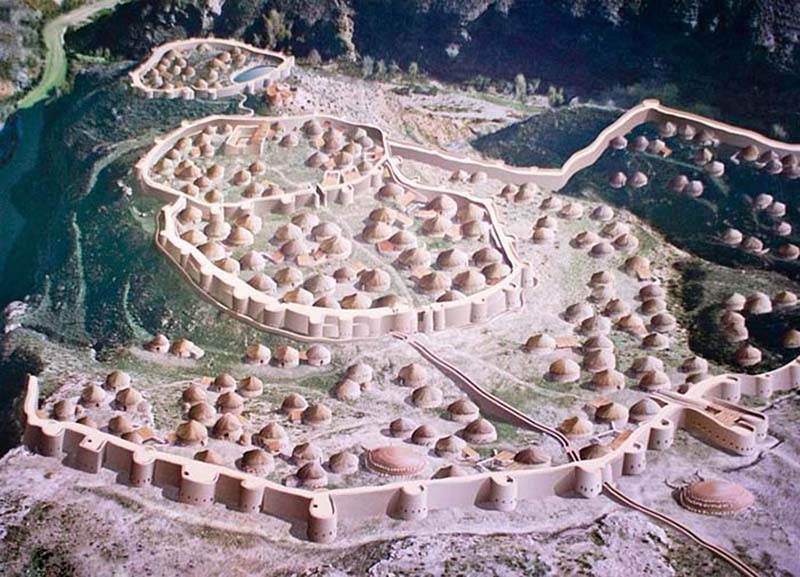
A model of the prehistoric town of Los Millares 3000 BC Spain, with its walls.

Fortifications are military constructions and buildings designed for defense in warfare and military bases. Humans have constructed defensive works for many thousands of years, in a variety of increasingly complex designs. The term is derived from the Latin fortis ("strong") and facere ("to make").
Many military installations are known as forts, although they are not always fortified. Larger forts may class as fortresses; smaller ones formerly often bore the name of fortalices. The word fortification can also refer to the practice of improving an area's defense with defensive works. City walls are fortifications but not necessarily called fortresses.
A defensive wall is a fortification used to protect a city or settlement from potential aggressors. In ancient to modern times, they were used to enclose settlements. Generally, these are referred to as city walls or town walls, although there were also walls, such as the Great Wall of China, Hadrian's Wall, and the metaphorical Atlantic Wall, which extended far beyond the borders of a city and were used to enclose regions or mark territorial boundaries. Beyond their defensive utility, many walls also had important symbolic functions - representing the status and independence of the communities they embraced.
The art of setting out a military camp or constructing a fortification traditionally classifies as castramentation, since the time of the Roman legions. The art/science of laying siege to a fortification and of destroying it has the popular name of siegecraft or 'siege warfare' and the formal name of poliorcetics. In some texts this latter term also applies to the art of building a fortification.
Fortification is usually divided into two branches, namely permanent fortification and field fortification. Permanent fortifications are erected at leisure, with all the resources that a state can supply of constructive and mechanical skill, and are built of enduring materials. Field fortifications, for example breastworks, are extemporized by troops in the field, perhaps assisted by such local labour and tools as may be procurable and with materials that do not require much preparation, such as earth, brushwood and light timber, or sandbags.
There is also an intermediate branch known as semi-permanent fortification. This is employed when in the course of a campaign it becomes desirable to protect some locality with the best imitation of permanent defenses that can be made in a short time, ample resources and skilled civilian labour being available.
Castles are fortifications which are regarded as being distinct from the generic fort or fortress in that it describes a residence of a monarch or noble and commands a specific defensive territory.
Existing ancient walls are almost always masonry structures, although brick and timber-built variants are also known. Depending on the topography of the area surrounding the city or the settlement the wall is intended to protect, elements of the terrain (e.g. rivers or coastlines) may be incorporated in order to make the wall more effective.
Walls may only be crossed by entering the appropriate city gate and are often supplemented with towers. In the Middle Ages, the right of a settlement to build a defensive wall was a privilege, and was usually granted by the so-called "right of crenellation" on a medieval fortification. The practice of building these massive walls, though having its origins in prehistory, was refined during the rise of city-states, and energetic wall-building continued into the medieval period and beyond in certain parts of Europe.
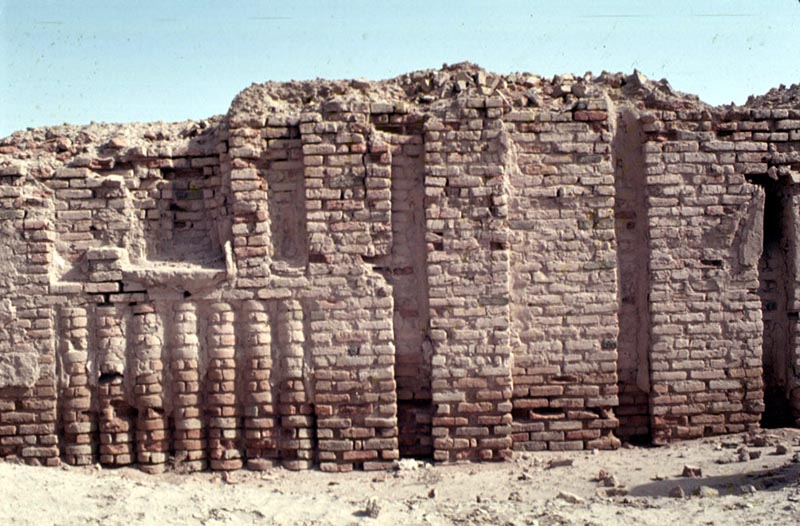
From very early history to modern times, walls have been a necessity for many cities. Uruk in ancient Sumer (Mesopotamia) is one of the world's oldest known walled cities.

Many of the fortifications of the ancient world were built with mud brick, leaving many no more than mounds of dirt for today's archaeologists. The Assyrians deployed large labour forces to build new palaces, temples and defensive walls. Babylon was one of the most famous cities of the ancient world, especially as a result of the building program of Nebuchadnezzar, who expanded the walls and built the Ishtar Gate.

The Ancient Egyptians also built fortresses on the frontiers of the Nile Valley to protect against invaders from its neighboring territories.
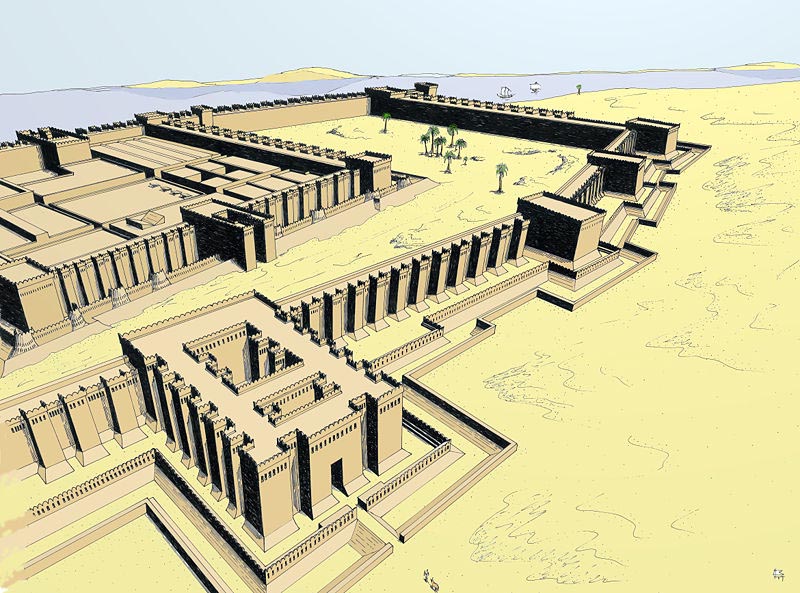
Artists impression of the battlements at Buhen fortress in Egypt about 1800 BC
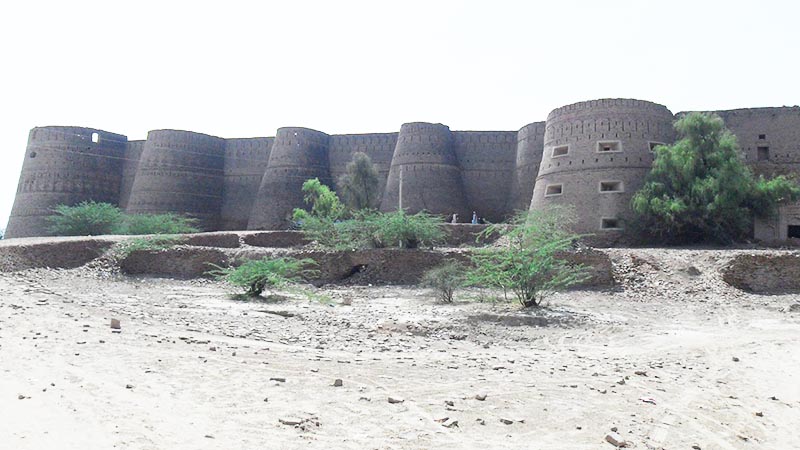
Some settlements in the Indus Valley Civilization were also fortified. By about 3500 B.C., hundreds of small farming villages dotted the Indus floodplain. Many of these settlements had fortifications and planned streets. The stone and mud brick houses of Kot Diji were clustered behind massive stone flood dykes and defensive walls, for neighboring communities bickered constantly about the control of prime agricultural land. Mundigak (c. 2500 B.C.) in present day south-east Afghanistan has defensive walls and square bastions of sun dried bricks.
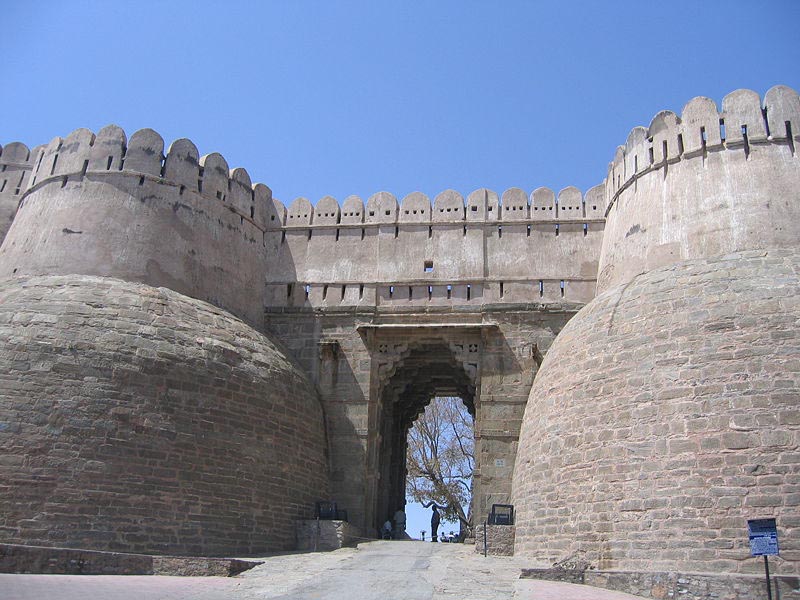
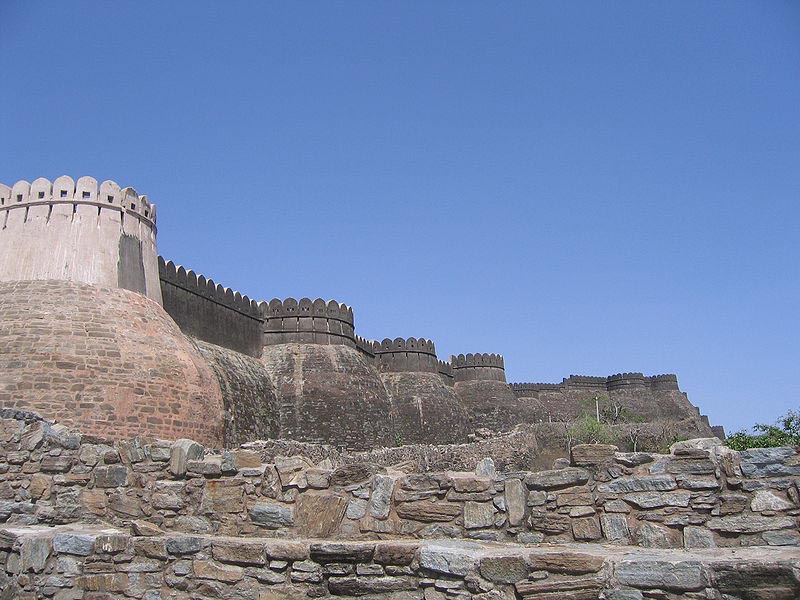
The Kumbhalgarh Fort in Rajasthan, India. For more than 3 centuries, the Fort remained impregnable. Kumbhalgarh is a Mewar fortress in the Rajsamand District of Rajasthan state in western India. Built during the course of the 15th century by Rana Kumbha, and enlarged through the 19th century, Kumbhalgarh is also a birthplace of Maharana Pratap, the great king and warrior of Mewar. Occupied until the late 19th century, the fort is now open to the general public as a museum and is spectacularly lit for a few minutes each evening. Kumbalgarh is situated 82 km from Udaipur towards its northwest and is easily accessible by road. It is the most important fort in Mewar after Chittaurgarh.

Large tempered earth (i.e. rammed earth) walls were built in ancient China since the Shang Dynasty (c. 1600-1050 BC), as the capital at ancient Ao had enormous walls built in this fashion. Although stone walls were built in China during the Warring States (481-221 BC), mass conversion to stone architecture did not begin in earnest until the Tang Dynasty (618-907 AD). In terms of China's longest and most impressive fortification, the Great Wall had been built since the Qin Dynasty (221-207 BC), although its present form was mostly an engineering feat and remodeling of the Ming Dynasty (1368-1644 AD). The large walls of Pingyao serve as one example. Likewise, the famous walls of the Forbidden City in Beijing were established in the early 15th century by the Yongle Emperor.
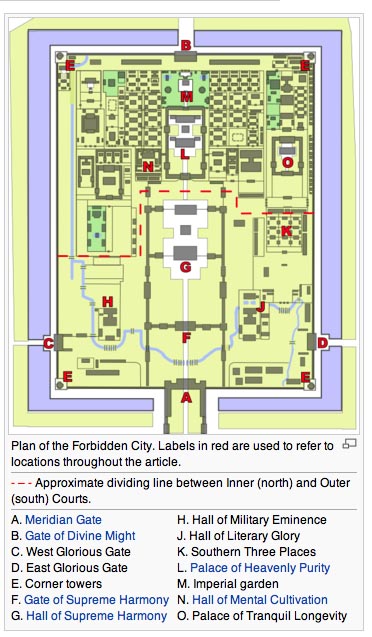
The Forbidden City was the Chinese imperial palace from the Ming Dynasty to the end of the Qing Dynasty. It is located in the middle of Beijing, China, and now houses the Palace Museum. For almost 500 years, it served as the home of emperors and their households, as well as the ceremonial and political center of Chinese government.
Built in 1406 to 1420, the complex consists of 980 buildings and covers 720,000 m2 (7,800,000 sq ft). The palace complex exemplifies traditional Chinese palatial architecture, and has influenced cultural and architectural developments in East Asia and elsewhere. The Forbidden City was declared a World Heritage Site in 1987, and is listed by UNESCO as the largest collection of preserved ancient wooden structures in the world.
Since 1925, the Forbidden City has been under the charge of the Palace Museum, whose extensive collection of artwork and artifacts were built upon the imperial collections of the Ming and Qing dynasties. Part of the museum's former collection is now located in the National Palace Museum in Taipei. Both museums descend from the same institution, but were split after the Chinese Civil War.
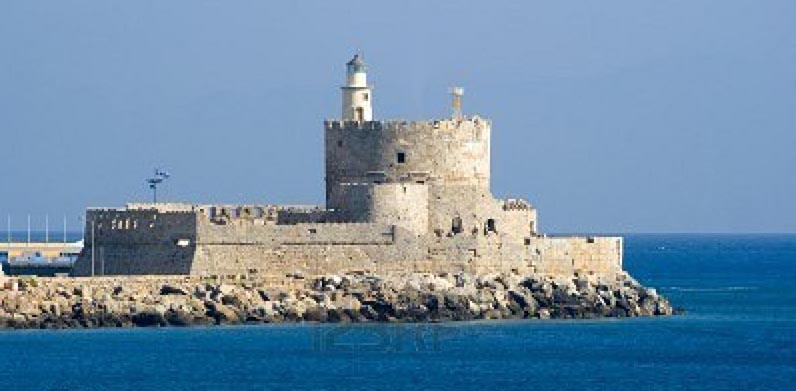
In ancient Greece, large stone walls had been built in Mycenaean Greece, such as the ancient site of Mycenae (famous for the huge stone blocks of its 'cyclopean' walls). In classical era Greece, the city of Athens built a long set of parallel stone walls called the Long Walls that reached their guarded seaport at Piraeus.
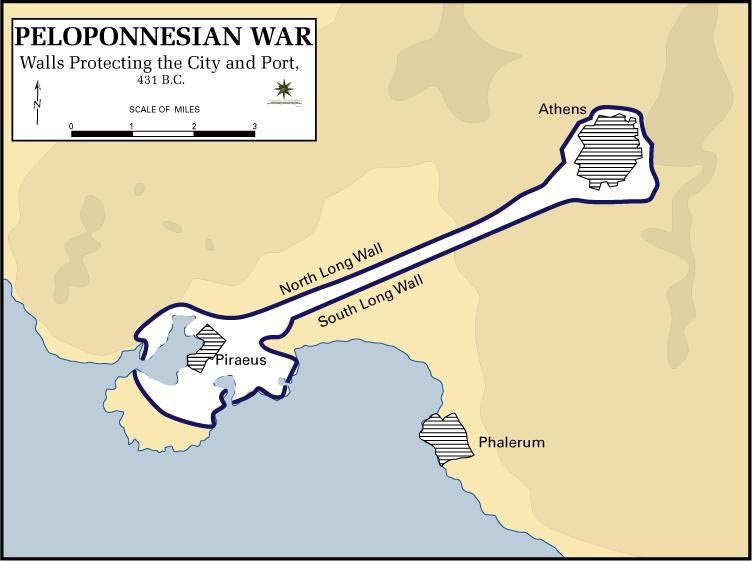
The Long Walls in Ancient Greece, were walls built from a city to its port, providing a secure connection to the sea even during times of siege. Although long walls were built at several locations in Greece - Corinth and Megara being two of the best known examples - the phrase "long walls" generally refers to the walls connecting Athens to its ports at Piraeus and Phalerum. Those walls were constructed in the mid 5th century BC, destroyed by the Spartans in 404 BC after Athens' defeat in the Peloponnesian War, and rebuilt again with Persian support during the Corinthian War. They were a key element of Athenian strategy, since they provided the city with a constant link to the sea and prevented it from being besieged by land alone.
The original walls of Athens had been destroyed by the Persians during the occupations of Attica in 480 and 479 BC, part of the Greco-Persian Wars. After the Battle of Plataea, the Persian forces that had invaded Greece in 480 BC were safely removed, and the Athenians were free to reoccupy their land and begin rebuilding their city. Early in the process of rebuilding, construction was started on new walls around the city proper. This project drew opposition from the Spartans and their Peloponnesian allies, who had been alarmed by the recent increase in the power of Athens.
Spartan envoys urged the Athenians not to go through with the construction, arguing that a walled Athens would be a useful base for an invading army, and that the defenses of the isthmus of Corinth would provide a sufficient shield against invaders; however, despite these concerns the envoys did not strongly protest and did in fact give advice to the builders. The Athenians disregarded the arguments, fully aware that leaving their city unwalled would place them utterly at the mercy of the Peloponnesians; Thucydides, in his account of these events, describes a series of complex machinations by Themistocles by which he distracted and delayed the Spartans until the walls had been built up to such a height as to be defensible.
In the early 450s BC, fighting began between Athens and various Peloponnesian allies of Sparta, particularly Corinth and Aegina. In the midst of this fighting, Athens had begun construction of two more walls between 462 BC and 458 BC, one running from the city to the old port at Phalerum, the other to the newer port at Piraeus. In 457 BC, a Spartan army defeated an Athenian army at Tanagra while attempting to prevent the construction, but work on the walls continued, and they were completed soon after the battle. These new walls, the Long W
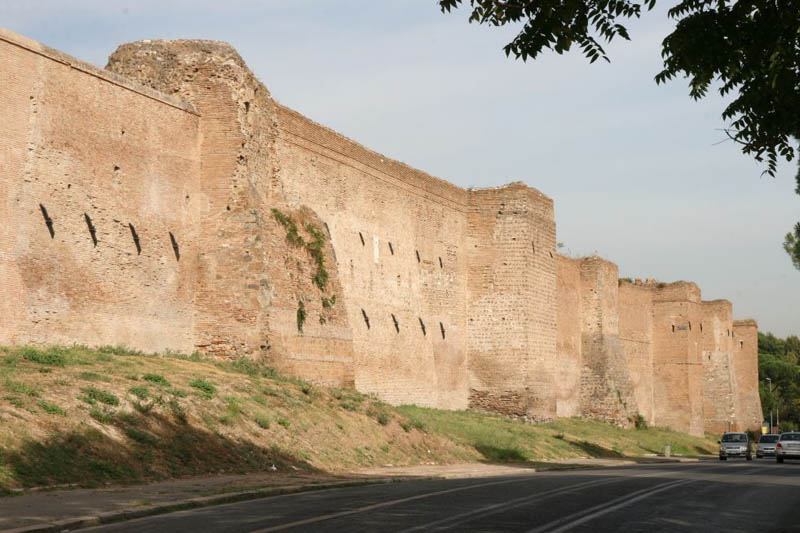
The Romans fortified their cities with massive, mortar-bound stone walls. The most famous of these are the largely extant Aurelian Walls of Rome and the Theodosian Walls of Constantinople, together with partial remains elsewhere. These are mostly city gates, like the Porta Nigra in Trier or Newport Arch in Lincoln.
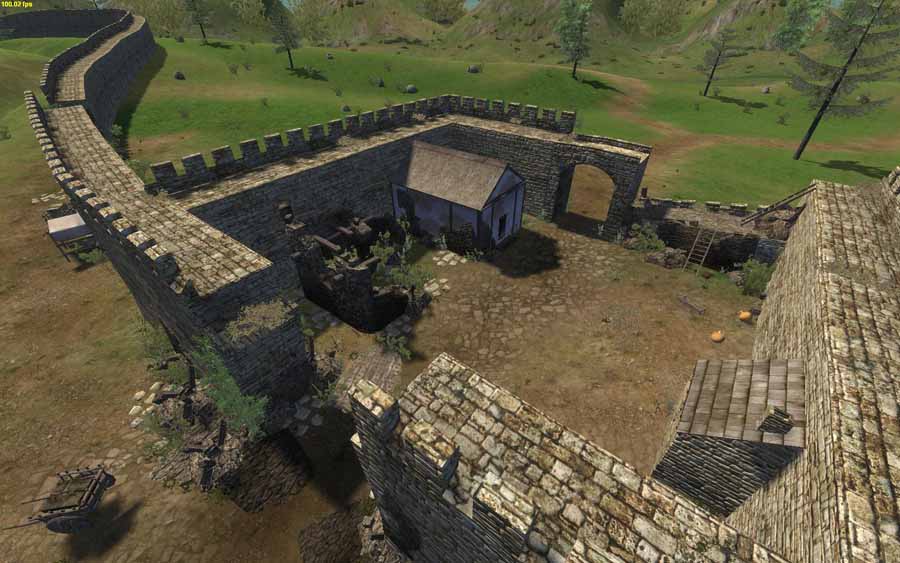
Hadrian's Wall was built by the Roman Empire across the width of what is now northern England following a visit by Roman Emperor Hadrian (AD 76-138) in AD 122. Hadrian's Wall is a stone and turf fortification built by the Roman Empire across the width of modern-day England. It was the second of three such fortifications built across Great Britain, the first being Gask Ridge and the last the Antonine Wall. All three were built to prevent military raids by the Pictish tribes (ancient inhabitants of Scotland) to the north, to improve economic stability and provide peaceful conditions in the Roman province of Britannia to the south, and to mark physically the frontier of the Empire. Hadrian's Wall is the best known of the three because its physical presence remains most evident today. alls, ensured that Athens would never be cut off from supplies as long as she controlled the sea.
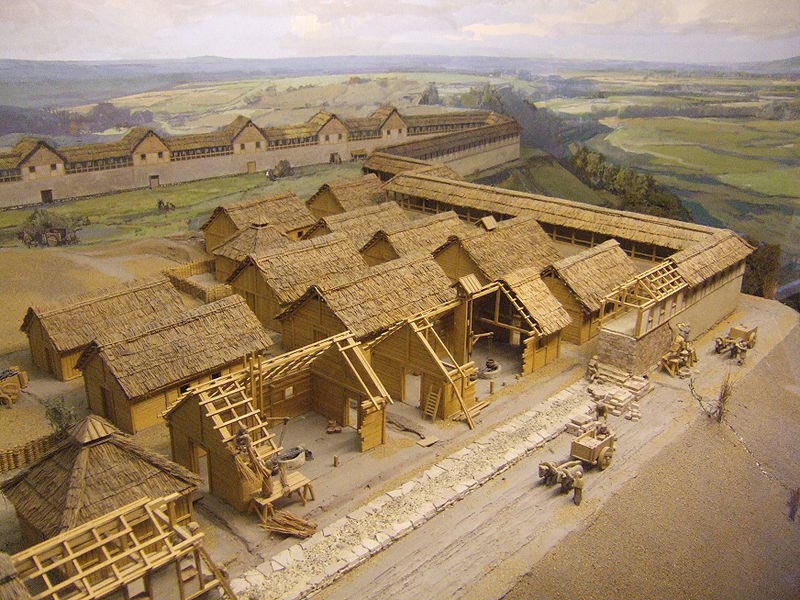
Around 600 BC, in Heuneburg, Germany, forts were constructed with a limestone foundation supported by a mudbrick wall approximately 4 meters tall, probably topped by a roofed walkway, thus reaching a total height of 6 meters. The wall was clad with lime plaster, regularly renewed. Towers protruded outwards from the wall.
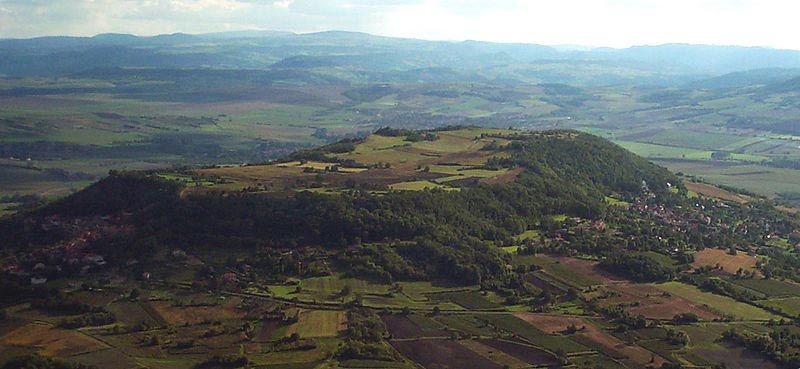
In Central Europe, the Celts built large fortified settlements known as oppida, whose walls seem partially influenced by those built in the Mediterranean. The fortifications were continuously being expanded and improved. An oppidum (plural oppida) is a large defended Iron Age settlement. They emerged in the 2nd and 1st centuries BC and spread across Europe, stretching from Britain in the west to the edge of the Hungarian plain in the east. They continued in use until the Romans began conquering Europe. North of the River Danube, where the population remained independent from Rome, oppida continued to be used into the 1st century.

Walls of Constantinople
The Walls of Constantinople are a series of defensive stone walls that have surrounded and protected the city of Constantinople (today Istanbul in Turkey) since its founding as the new capital of the Roman Empire by Constantine the Great. With numerous additions and modifications during their history, they were the last great fortification system of antiquity, and one of the most complex and elaborate systems ever built.
Initially built by Constantine the Great, the walls surrounded the new city on all sides, protecting it against attack from both sea and land. As the city grew, the famous double line of the Theodosian Walls was built in the 5th century. Although the other sections of the walls were less elaborate, when well manned, they were almost impregnable for any medieval besieger, saving the city, and the Byzantine Empire with it, during sieges from the Avars, Arabs, Rus', and Bulgars, among others (see Sieges of Constantinople). The advent of gunpowder siege cannons rendered the fortifications vulnerable, but cannon technology was not advanced enough to be decisive enough alone to capture the city, and the walls were repaired between reloading. Ultimately the city fell from sheer force of Ottoman forces on 29 May 1453 after a 6-week siege.
The walls were largely maintained intact during most of the Ottoman period, until sections began to be dismantled in the 19th century, as the city outgrew its medieval boundaries. Despite the subsequent lack of maintenance, many parts of the walls survived and are still standing today. A large-scale restoration program has been under way since the 1980s, which allows the visitor to appreciate their original appearance.
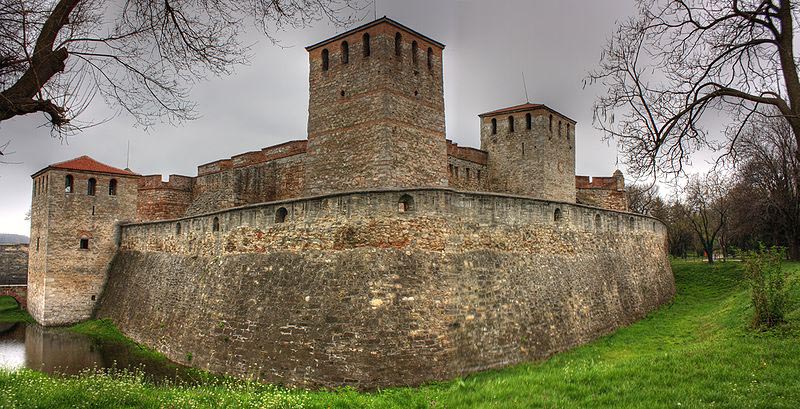
Well preserved Bulgarian medieval fort Baba Vida
Roman forts and hill forts were the main antecedents of castles in Europe, which emerged in the 9th century in the Carolingian Empire.
The Early Middle Ages saw the creation of some towns built around castles. These cities were only rarely protected by simple stone walls and more usually by a combination of both walls and ditches. From the 12th century AD hundreds of settlements of all sizes were founded all across Europe, which very often obtained the right of fortification soon afterwards.
The founding of urban centres was an important means of territorial expansion and many cities, especially in eastern Europe, were founded precisely for this purpose during the period of Eastern Colonization. These cities are easy to recognize due to their regular layout and large market spaces. The fortifications of these settlements were continuously improved to reflect the current level of military development.
During the Renaissance era, the Venetians raised great walls around cities threatened by the Ottoman empire. The finest examples are, among others, in Nicosia (Cyprus) and Chania (Crete), and they still stand, to this day.
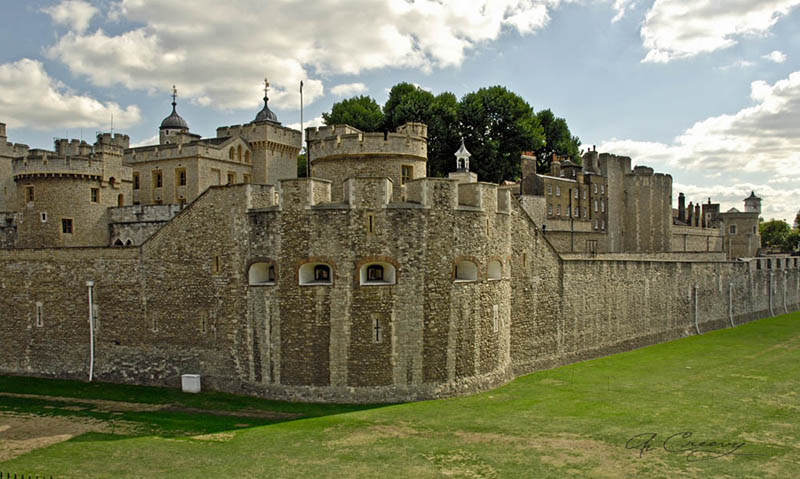
London Tower of London Fortress
Her Majesty's Royal Palace and Fortress, more commonly known as the Tower of London, is a historic castle on the north bank of the River Thames in central London, England. It lies within the London Borough of Tower Hamlets, separated from the eastern edge of the City of London by the open space known as Tower Hill. It was founded towards the end of 1066 as part of the Norman Conquest of England.
The White Tower, which gives the entire castle its name, was built by William the Conqueror in 1078, and was a resented symbol of oppression, inflicted upon London by the new ruling elite. The castle was used as a prison since at least 1100, although that was not its primary purpose. A grand palace early in its history, it served as a royal residence. As a whole, the Tower is a complex of several buildings set within two concentric rings of defensive walls and a moat. There were several phases of expansion, mainly under Kings Richard the Lionheart, Henry III, and Edward I in the 12th and 13th centuries. The general layout established by the late 13th century remains despite later activity on the site.
The Tower of London has played a prominent role in English history. It was besieged several times and controlling it has been important to controlling the country. The Tower has served variously as an armoury, a treasury, a menagerie, the home of the Royal Mint, a public records office, and the home of the Crown Jewels of the United Kingdom. From the early 14th century until the reign of Charles II, a procession would be led from the Tower to Westminster Abbey on the coronation of a monarch. In the absence of the monarch, the Constable of the Tower is in charge of the castle. This was a powerful and trusted position in the medieval period. In the late 15th century the castle was the prison of the Princes in the Tower. Under the Tudors, the Tower became used less as a royal residence, and despite attempts to refortify and repair the castle its defenses lagged behind developments to deal with artillery.
The peak period of the castle's use as a prison was the 16th and 17th centuries, when many figures who had fallen into disgrace, such as Elizabeth I before she became queen, were held within its walls. This use has led to the phrase "sent to the Tower". Despite its enduring reputation as a place of torture and death, popularized by 16th-century religious propagandists and 19th-century writers, only seven people were executed within the Tower before the World Wars of the 20th century. Executions were more commonly held on the notorious Tower Hill to the north of the castle, with 112 occurring there over a 400-year period. In the latter half of the 19th century, institutions such as the Royal Mint moved out of the castle to other locations, leaving many buildings empty.
Anthony Salvin and John Taylor took the opportunity to restore the Tower to what was felt to be its medieval appearance, clearing out many of the vacant post-medieval structures. In the First and Second World Wars, the Tower was again used as a prison, and witnessed the executions of 12 men for espionage. After the Second World War, damage caused during the Blitz was repaired and the castle reopened to the public. Today the Tower of London is one of the country's most popular tourist attractions. It is cared for by the charity Historic Royal Palaces and is protected as a World Heritage Site.
Medieval-style fortifications were largely made obsolete by the arrival of cannons on the 14th century battlefield. Fortifications in the age of blackpowder evolved into much lower structures with greater use of ditches and earth ramparts that would absorb and disperse the energy of cannon fire. Walls exposed to direct cannon fire were very vulnerable, so were sunk into ditches fronted by earth slopes.
This placed a heavy emphasis on the geometry of the fortification to allow defensive cannonry interlocking fields of fire to cover all approaches to the lower and thus more vulnerable walls.
The evolution of this new style of fortification can be seen in transitional forts such as Sarzanello in North West Italy which was built between 1492 and 1502. Sarzanello consists of both crenellated walls with towers typical of the medieval period but also has a ravelin like angular gun platform screening one of the curtain walls which is protected from flanking fire from the towers of the main part of the fort. Another example are the fortifications of Rhodes which were frozen at 1522 so that Rhodes is the only European walled town that still shows the transition between the classical medieval fortification and the modern ones.
Fortifications also extended in depth, with protected batteries for defensive cannonry, to allow them to engage attacking cannon to keep them at a distance and prevent them bearing directly on the vulnerable walls.
The result was star shaped fortifications with tier upon tier of hornworks and bastions, of which Bourtange illustrated to the right is an excellent example. There are also extensive fortifications from this era in the Nordic states and in Britain, the fortifications of Berwick-upon-Tweed and the harbor archipelago of Suomenlinna at Helsinki being fine examples.
The arrival of explosive shells in the 19th century led to yet another stage in the evolution of fortification. Star forts of the cannon era did not fare well against the effects of high explosive and the intricate arrangements of bastions, flanking batteries and the carefully constructed lines of fire for the defending cannon could be rapidly disrupted by explosive shells.
Worse, the large open ditches surrounding forts of this type were an integral part of the defensive scheme, as was the covered way at the edge of the counter scarp. The ditch was extremely vulnerable to bombardment with explosive shells.
In response, military engineers evolved the polygonal style of fortification. The ditch became deep and vertically sided, cut directly into the native rock or soil, laid out as a series of straight lines creating the central fortified area that gives this style of fortification its name.
Wide enough to be an impassable barrier for attacking troops, but narrow enough to be a difficult target for enemy shellfire, the ditch was swept by fire from defensive blockhouses set in the ditch as well as firing positions cut into the outer face of the ditch itself.
The profile of the fort became very low indeed, surrounded outside the ditch by a gently sloping open area so as to eliminate possible cover for enemy forces, while the fort itself provided a minimal target for enemy fire. The entrypoint became a sunken gatehouse in the inner face of the ditch, reached by a curving ramp that gave access to the gate via a rolling bridge that could be withdrawn into the gatehouse.
Traditional fortification however continued to be applied by European armies engaged in warfare in colonies established in Africa against lightly armed attackers from amongst the indigenous population. A relatively small number of defenders in a fort impervious to iron-age weaponry could hold out against high odds, the only constraint being the supply of ammunition.
Much of the fort moved underground, with deep passages and tunnels to connect the blockhouses and firing points in the ditch to the fort proper, with magazines and machine rooms deep under the surface.
The guns however, were often mounted in open emplacements and protected only by a parapet - both in order to keep a lower profile and also because experience with guns in closed casemates had seen them put out of action by rubble as their own casemates were collapsed around them.
Steel-and-concrete fortifications were common during the 19th and early 20th centuries. However the advances in modern warfare since World War I have made large-scale fortifications obsolete in most situations. Only underground bunkers are still able to provide some protection in modern wars. Many historical fortifications were demolished during the modern age, but a considerable number survive as popular tourist destinations and prominent local landmarks today.
The downfall of permanent fortifications had two causes:
The ever escalating power, speed, and reach of artillery and air power meant that almost any target that could be located could be destroyed, if sufficient force were massed against it. As such, the more resources a defender devoted to reinforcing a fortification, the more combat power that fortification justified being devoted to destroying it, if the fortification's destruction was demanded by an attacker's strategy. From World War II, bunker busters were used against fortifications. By 1950, nuclear weapons were capable of destroying entire cities, and produced dangerous radiation. This led to the creation of civilian nuclear air raid shelters.
The second weakness of permanent fortification was its very permanency. Because of this it was often easier to go around a fortification and, with the rise of mobile warfare in the beginning of World War II, this became a viable offensive choice. When a defensive line was too extensive to be entirely bypassed, massive offensive might could be massed against one part of the line allowing a breakthrough, after which the rest of the line could be bypassed. Such was the fate of the many defensive lines built before and during World War II, such as the Siegfried Line, the Stalin Line and the Atlantic Wall. Note that this was not the case of the Maginot Line, designed to force the Germans to pass through Belgium and that has fully achieved its political and strategic role.
Instead field fortification rose to dominate defensive action. Unlike the trench warfare which dominated World War I, these defences were more temporary in nature. This was an advantage because since it was less extensive it formed a less obvious target for enemy force to be directed against.
If sufficient power were massed against one point to penetrate it, the forces based there could be withdrawn and the line could be re-established relatively quickly. Instead of a supposedly impenetrable defensive line, such fortifications emphasized defense in depth, so that as defenders were forced to pull back or were overrun, the lines of defenders behind them could take over the defense.
Because the mobile offensives practiced by both sides usually focused on avoiding the strongest points of a defensive line, these defenses were usually relatively thin and spread along the length of a line. The defense was usually not equally strong throughout however.
The strength of the defensive line in an area varied according to how rapidly an attacking force could progress in the terrain that was being defended - both the terrain the defensive line was built on and the ground behind it that an attacker might hope to break out into. This was both for reasons of the strategic value of the ground, and its defensive value.
This was possible because while offensive tactics were focused on mobility, so were defensive tactics. The dug in defenses consisted primarily of infantry and antitank guns. Defending tanks and tank destroyers would be concentrated in mobile "Fire Brigades" behind the defensive line. If a major offensive was launched against a point in the line, mobile reinforcements would be sent to reinforce that part of the line that was in danger of failing.
Thus the defensive line could be relatively thin because the bulk of the fighting power of the defenders was not concentrated in the line itself but rather in the mobile reserves. A notable exception to this rule was seen in the defensive lines at the Battle of Kursk during World War II, where German forces deliberately attacked into the strongest part of the Soviet defenses seeking to crush them utterly.
The terrain that was being defended was of primary importance because open terrain that tanks could move over quickly made possible rapid advances into the defenders' rear areas that were very dangerous to the defenders. Thus such terrain had to be defended at all cost.
In addition, since in theory the defensive line only had to hold out long enough for mobile reserves to reinforce it, terrain that did not permit rapid advance could be held more weakly because the enemy's advance into it would be slower, giving the defenders more time to reinforce that point in the line. For example, the battle of the Hurtgen Forest in Germany during the closing stages of World War II is an excellent example of how impassable terrain could be used to the defenders' advantage.
After World War II, ICBMs capable of reaching much of the way around the world were developed, and so speed became an essential characteristic of the strongest militaries and defenses. Missile silos were developed, so missiles could be fired from the middle of a country and hit cities and targets in another country, and airplanes (and air carriers) became major defenses and offensive weapons (leading to an expansion of the use of airports and airstrips as fortifications).
Mobile defenses could be had underwater, too, in the form of nuclear submarines capable of firing missiles. Some bunkers in the mid to late 20th century came to be buried deep inside mountains and prominent rocks, such as Gibraltar and Cheyenne Mountain. On the ground itself, minefields have been used as hidden defenses in modern warfare, often remaining long after the wars that have produced them have ended.
Demilitarized zones along borders are arguably another type of fortification, although a passive kind, providing a buffer between potentially hostile militaries.
Just as in colonial periods, comparatively obsolete fortifications are still used for low-intensity conflicts. Such fortifications range in size from small patrol bases or forward operating bases up to huge airbases such as Camp Bastion/Leatherneck in Afghanistan. Much like in the 18th and 19th century, because the enemy is not a powerful military force with the heavy weaponry required to destroy fortifications, walls of gabion, sandbag or even simple mud can provide protection against small arms and anti-tank weapons - although such fortifications are still vulnerable to mortar and artillery fire.
Forts in modern usage often refer to space set aside by governments for a permanent military facility; these often do not have any actual fortifications, and can have specializations (military barracks, administration, medical facilities, or intelligence). In the United States usage, forts specifically refer to Army fortifications; Marine Corps fortifications are referred to as camps.
However there are some modern fortifications that are referred to as forts. These are typically small semi permanent fortifications. In urban combat they are built by upgrading existing structures such as houses or public buildings. In field warfare they are often log, sandbag or gabion type construction.
Such forts are typically only used in low level conflict, e.g., counterinsurgency conflicts or very low level conventional conflicts, e.g., the IndonesiaĞMalaysia confrontation saw the use of log forts for use by forward platoons and companies. The reason for this is that static above ground forts can not survive modern direct or indirect fire weapons larger than mortars, RPGs and small arms.